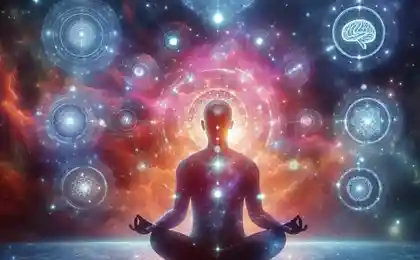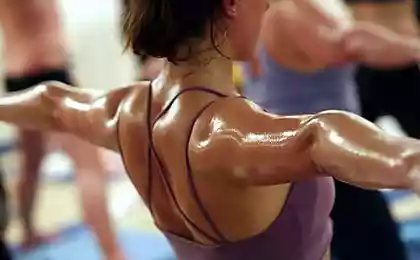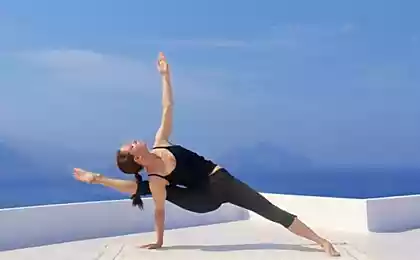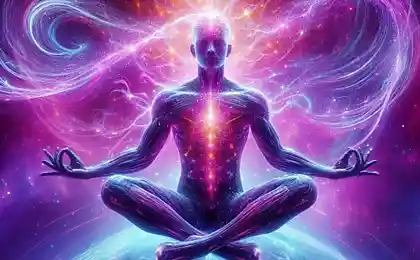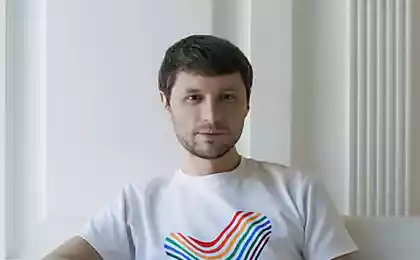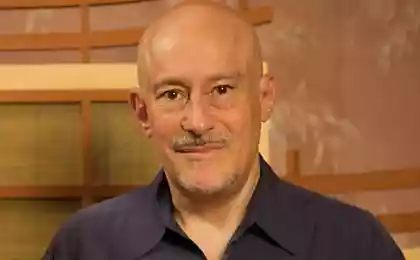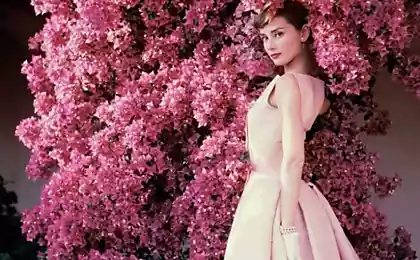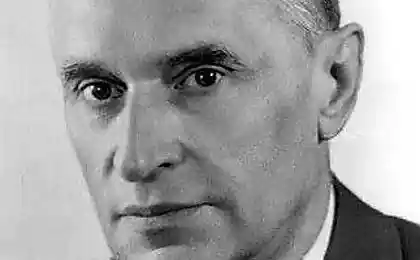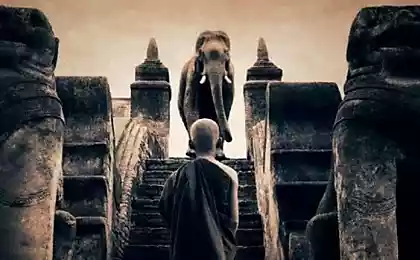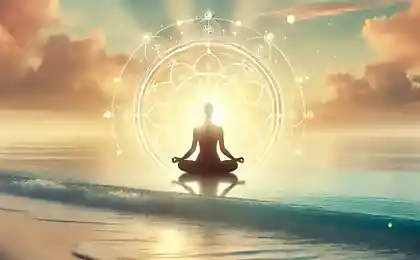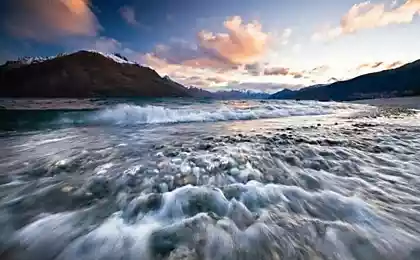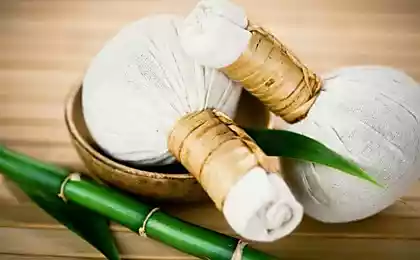500
Chandrasana is a wonderful polymastic. The nuances of practice
Execution:
Lie on Mat on your back. Close your eyes and completely relax the whole body. Bend knees, placing feet flat on floor (not on the toes). Feet and knees hip distance apart or together. Firmly grab the Shin. Take a deep breath, hold your breath. And hold to raise the pelvis as high as possible. Bend the chest wall, guiding the bottom edge up and raise the chest as high as possible. When the delay becomes uncomfortable, with access to lower torso on the floor. Relax a short time (usually 5-10 cycles of breath, or 1 minute), in Savasana, eyes closed, Rosslau whole body. Perform a total of 5-10 of these approaches.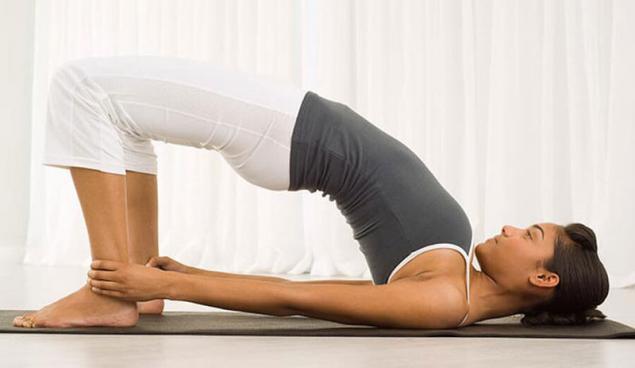
Questions on this posture usually occurs in the preparation of:
What should be the width of the foot and knees? Someone of the instructors requires "feet together". In the Bihar school is practiced usually by placement of the feet and knees are shoulder-width apart — this gives "space" to the organs of the urogenital system helps to develop them (through tension and then relaxation), without clamping. In addition, the position slightly spaced support feet more steadily and comfortably. With the head and feet are narrow but still a triangle, and it's good for support. If spread too wide, posture of the force goes to do it gets hard, and the knee "pop" — uncomfortable. The most safe for the knees and requires no muscular effort position when the legs are bent at a right angle (90°), it is easy to check in the mirror or touch (the head in this position, it is better not to twist). Hands lying on the floor and you hold the drumsticks, create additional contour support. That is, the weight of the body in the end position that you hold, "goes to ground" through the feet, hands along the entire length, shoulders, neck and head (neck). Not only the feet and the back of the head (otherwise that's another pose called "an elongated bridge"!). Further, how best to work with the breath in this pose? In fact, no single answer. It is necessary to listen to your body, and to do so, so not much to tired to power did not go, but added.
For the majority of people are two options:
Breath in the supine position. Entrance into the pose and hold — on delay after the inhalation (Antar Kumbhaka). Exhale, lowering the body to its original position. Breath in the supine position, or lifting the pelvis and body upwards. Deep, slow breathing in the final position. Exhale, lowering the body to its original position. Limit hold poses — from 10-15 minutes to 45 minutes, which is practiced for therapeutic purposes (exercise "the orgasm Reflex" Reich) does not require any special breathing. In a natural way can be replaced by periods of shallow, deep and slow "Full yoga", and holotropic breathing. In Savasana after practicing breathing returning to normal. Additional work of breathing is not required here. Traumatic moments:
In this position it is possible to obtain a neck injury. It is necessary to pay special attention to the comfort of the neck. Don't have to pull the head. From initially arrange your head and neck comfortably. If that fails — put a folded blanket or folded 4 times extra thin, yogamat under the shoulders — the neck should hang a "bridge". At the same time, the back of the head can not be put on the hard (on the floor), and also on a soft, non-slip support. The knees should not feel discomfort. If the wrong retention leg muscles will tire quickly, and is unlikely to injure themselves, but the effect will accumulate. Please note that the knees were bent at a right angle, and the heel was located well under the knee cap. Some people in this (right) the position of the hand can't reach your shins, and hold on to the tibia is not possible. Nothing to worry about! Most importantly true to put feet and hands can simply be put along the body. If the knees are working correctly, the position of comfort, and hands to take the legs do not have. However, if you want to accentuate the deflection of the back, and flip back, then you need a lever, and take for drive hands still need. Therefore, the position with the hands behind the tibia — a classic, basic variation of this pose. Don't need much to strain your eyes and General face. If you feel or see in the mirror, in the eyes burst a blood vessel, you probably did the pose wrong, or just excessive stress (this applies to all inverted poses where the pelvis above the head). Ask for edits, control by the instructor asanas. Eyes have to be closed. If it is psychological discomfort you anxious — you can not close your eyes completely, just enough to cover them. Contraindications, limitations: the Pose is not suitable for people with high blood pressure, ulcer, Umbilical hernia repair, Serious diseases of the spine; There is a strict rule that in the later stages of pregnancy, the pelvis should not be lifted higher than 15 cm from the floor. That is this position do not work. Concentration, meditation: At run time, even already at the stage of entering the pose, release the mind, not think about anything. It is not necessary pogovarit to myself something like "Above the basin!", "So, even a little stronger to take the legs...". Do a pose as usual, as usual, not thinking and not "discussing" it in the head himself (itself) themselves. This is an important point! If the phase detuning calm the mind does not work, do not worry: your own posture as it turns out, "when the mind", but then "calm down" and admit that you are nothing more to do in the posture is not necessary. It is not necessary to discuss with them when to exit the pose will be released when the body so decides. Performing poses with incessant "chatter" in the head — to put it mildly, very far from perfect, how would you beautiful neither have built a position. This is not yoga, just a gymnastic exercise in this case. The concentration recommended is this: for beginners (development posture) — on the correctness of the detuning and the entrance to the pose, to "massage" the influence of posture on the abdomen, on the deflection. For the experienced — on the breath and internal sensations in the body and state of mind (silence the mind). For advanced practitioners, Vishuddhi or Anahata-chakra and their dynamics during execution. Eyes in Drishti (concentration) can participate — that is, it is possible to physically direct the gaze to the point of concentration — for example, in the center of the chest — but in this case the eyelids are closed (otherwise the eyes, you'll overextend!). In limit hold — 20-30 minutes ("the Reflex of the orgasm"by Wilhelm Reich) it is necessary to observe the "stream of consciousness", the content of the mind and "let go" of everything that comes into "sight" of the mind, what you pay attention to how "outside" (body region discomfort, pain) and "inside" (traumatic situations and negative emotions — passions and mind of toxins, which are released and float before the mind's eye before leaving the body). If necessary, this process can help deep and slow, Full yoga, or fast, associated with (holotropic) breath. The psychological benefit of such exercises is difficult to overestimate! Also this way you can remove the blocks and tension from the region of the urogenital system, with the purpose of improving the condition of bodies of this region, family life and psychological background (changing the "middle States"). To achieve such purposes, may need repeated or more sessions, with a break for full muscle recovery (within 1-2 weeks or even a month). Limit hold "force of will" can, after passing through the phase of "purification of mind from mental garbage" output to the level of silence of the mind, Chitta Vritti Nirodha. Therefore, it is recommended to those who persistently fails to calm the mind usual method — focusing on the revision of the position of the body and the sensations of the breath or even at the chakras. Limit hold recommended for women with frigidity or other similar problems, and anyone experiencing high stress, or "loss of taste for life", "crisis" or recently have experienced psychological shock, depression, people with alcohol or drug addiction (unless contraindicated for health reasons, of course), or if you "felt ceiling" in my yoga practice. This position, at extreme hold, resets and recharges the entire pranic system, and can "automatically" — at the expense of physical strength — show to the highest stages of meditative experiences, as well as, of course, trains the will. At the limiting retention is necessary to pay special attention of risk of injury at the neck and the knees; if you previously had problems with the knees, the knees — use a soft cuff to the knee. As we have seen from this analysis, this "trivial" at first glance, asana offers a set of useful effects and opportunities for self-development, as in regular, so even when a single (marginal) performance.published
Author: Alex Sokolovsky
P. S. And remember, just changing your mind — together we change the world! ©
Join us in Facebook and in Vkontakte, and we're Classmates
Source: hanuman.ru/blog/yoga-dlya-nachinayushchikh/kandarasana-chudesny-polumostik-nyuansy-praktiki
Lie on Mat on your back. Close your eyes and completely relax the whole body. Bend knees, placing feet flat on floor (not on the toes). Feet and knees hip distance apart or together. Firmly grab the Shin. Take a deep breath, hold your breath. And hold to raise the pelvis as high as possible. Bend the chest wall, guiding the bottom edge up and raise the chest as high as possible. When the delay becomes uncomfortable, with access to lower torso on the floor. Relax a short time (usually 5-10 cycles of breath, or 1 minute), in Savasana, eyes closed, Rosslau whole body. Perform a total of 5-10 of these approaches.

Questions on this posture usually occurs in the preparation of:
What should be the width of the foot and knees? Someone of the instructors requires "feet together". In the Bihar school is practiced usually by placement of the feet and knees are shoulder-width apart — this gives "space" to the organs of the urogenital system helps to develop them (through tension and then relaxation), without clamping. In addition, the position slightly spaced support feet more steadily and comfortably. With the head and feet are narrow but still a triangle, and it's good for support. If spread too wide, posture of the force goes to do it gets hard, and the knee "pop" — uncomfortable. The most safe for the knees and requires no muscular effort position when the legs are bent at a right angle (90°), it is easy to check in the mirror or touch (the head in this position, it is better not to twist). Hands lying on the floor and you hold the drumsticks, create additional contour support. That is, the weight of the body in the end position that you hold, "goes to ground" through the feet, hands along the entire length, shoulders, neck and head (neck). Not only the feet and the back of the head (otherwise that's another pose called "an elongated bridge"!). Further, how best to work with the breath in this pose? In fact, no single answer. It is necessary to listen to your body, and to do so, so not much to tired to power did not go, but added.
For the majority of people are two options:
Breath in the supine position. Entrance into the pose and hold — on delay after the inhalation (Antar Kumbhaka). Exhale, lowering the body to its original position. Breath in the supine position, or lifting the pelvis and body upwards. Deep, slow breathing in the final position. Exhale, lowering the body to its original position. Limit hold poses — from 10-15 minutes to 45 minutes, which is practiced for therapeutic purposes (exercise "the orgasm Reflex" Reich) does not require any special breathing. In a natural way can be replaced by periods of shallow, deep and slow "Full yoga", and holotropic breathing. In Savasana after practicing breathing returning to normal. Additional work of breathing is not required here. Traumatic moments:
In this position it is possible to obtain a neck injury. It is necessary to pay special attention to the comfort of the neck. Don't have to pull the head. From initially arrange your head and neck comfortably. If that fails — put a folded blanket or folded 4 times extra thin, yogamat under the shoulders — the neck should hang a "bridge". At the same time, the back of the head can not be put on the hard (on the floor), and also on a soft, non-slip support. The knees should not feel discomfort. If the wrong retention leg muscles will tire quickly, and is unlikely to injure themselves, but the effect will accumulate. Please note that the knees were bent at a right angle, and the heel was located well under the knee cap. Some people in this (right) the position of the hand can't reach your shins, and hold on to the tibia is not possible. Nothing to worry about! Most importantly true to put feet and hands can simply be put along the body. If the knees are working correctly, the position of comfort, and hands to take the legs do not have. However, if you want to accentuate the deflection of the back, and flip back, then you need a lever, and take for drive hands still need. Therefore, the position with the hands behind the tibia — a classic, basic variation of this pose. Don't need much to strain your eyes and General face. If you feel or see in the mirror, in the eyes burst a blood vessel, you probably did the pose wrong, or just excessive stress (this applies to all inverted poses where the pelvis above the head). Ask for edits, control by the instructor asanas. Eyes have to be closed. If it is psychological discomfort you anxious — you can not close your eyes completely, just enough to cover them. Contraindications, limitations: the Pose is not suitable for people with high blood pressure, ulcer, Umbilical hernia repair, Serious diseases of the spine; There is a strict rule that in the later stages of pregnancy, the pelvis should not be lifted higher than 15 cm from the floor. That is this position do not work. Concentration, meditation: At run time, even already at the stage of entering the pose, release the mind, not think about anything. It is not necessary pogovarit to myself something like "Above the basin!", "So, even a little stronger to take the legs...". Do a pose as usual, as usual, not thinking and not "discussing" it in the head himself (itself) themselves. This is an important point! If the phase detuning calm the mind does not work, do not worry: your own posture as it turns out, "when the mind", but then "calm down" and admit that you are nothing more to do in the posture is not necessary. It is not necessary to discuss with them when to exit the pose will be released when the body so decides. Performing poses with incessant "chatter" in the head — to put it mildly, very far from perfect, how would you beautiful neither have built a position. This is not yoga, just a gymnastic exercise in this case. The concentration recommended is this: for beginners (development posture) — on the correctness of the detuning and the entrance to the pose, to "massage" the influence of posture on the abdomen, on the deflection. For the experienced — on the breath and internal sensations in the body and state of mind (silence the mind). For advanced practitioners, Vishuddhi or Anahata-chakra and their dynamics during execution. Eyes in Drishti (concentration) can participate — that is, it is possible to physically direct the gaze to the point of concentration — for example, in the center of the chest — but in this case the eyelids are closed (otherwise the eyes, you'll overextend!). In limit hold — 20-30 minutes ("the Reflex of the orgasm"by Wilhelm Reich) it is necessary to observe the "stream of consciousness", the content of the mind and "let go" of everything that comes into "sight" of the mind, what you pay attention to how "outside" (body region discomfort, pain) and "inside" (traumatic situations and negative emotions — passions and mind of toxins, which are released and float before the mind's eye before leaving the body). If necessary, this process can help deep and slow, Full yoga, or fast, associated with (holotropic) breath. The psychological benefit of such exercises is difficult to overestimate! Also this way you can remove the blocks and tension from the region of the urogenital system, with the purpose of improving the condition of bodies of this region, family life and psychological background (changing the "middle States"). To achieve such purposes, may need repeated or more sessions, with a break for full muscle recovery (within 1-2 weeks or even a month). Limit hold "force of will" can, after passing through the phase of "purification of mind from mental garbage" output to the level of silence of the mind, Chitta Vritti Nirodha. Therefore, it is recommended to those who persistently fails to calm the mind usual method — focusing on the revision of the position of the body and the sensations of the breath or even at the chakras. Limit hold recommended for women with frigidity or other similar problems, and anyone experiencing high stress, or "loss of taste for life", "crisis" or recently have experienced psychological shock, depression, people with alcohol or drug addiction (unless contraindicated for health reasons, of course), or if you "felt ceiling" in my yoga practice. This position, at extreme hold, resets and recharges the entire pranic system, and can "automatically" — at the expense of physical strength — show to the highest stages of meditative experiences, as well as, of course, trains the will. At the limiting retention is necessary to pay special attention of risk of injury at the neck and the knees; if you previously had problems with the knees, the knees — use a soft cuff to the knee. As we have seen from this analysis, this "trivial" at first glance, asana offers a set of useful effects and opportunities for self-development, as in regular, so even when a single (marginal) performance.published
Author: Alex Sokolovsky
P. S. And remember, just changing your mind — together we change the world! ©
Join us in Facebook and in Vkontakte, and we're Classmates
Source: hanuman.ru/blog/yoga-dlya-nachinayushchikh/kandarasana-chudesny-polumostik-nyuansy-praktiki




